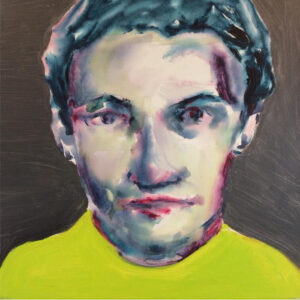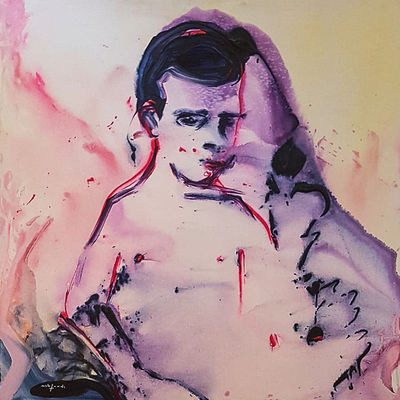
Omar Mahfoudi
About:
“My name is Omar Mahfoudi. Born in Tangier (Morocco) in 1981. I have been drawing, filming and photographing the contradictions of my native country and of the contemporary world for 20 years.

Untitled, 2019
I started drawing before learning how to write. It came to me naturally and enabled me to explore other images and drawings than those of the Moroccan society or of orientalist visions. I had the chance to have a middle-school professor who encouraged me in the pursuit of my practice. Starting from this moment, I got interested in art history. Through paintings, photographs and videos, I attempt to reinvent and rewrite human kind’s history through emotions, because I come from a culture where figurative art is prohibited. Also, in my culture, eroticism is limited to a hypocrite small part of life, though it deems that sensuality is of great importance. I question bodies and sexuality in daily life through eroticism proper to painting. My view is a result of fifteen years of reflection that I assimilated. Since 2016, my view of the word is influenced by the political and humanistic problematics, thus, giving my work a new momentum.

Untitlrd, 2019
My work for the animated pictorial film, an experimental video, testifies of my freedom of expression and my dissatisfied vision of the multiple paradoxes of the contemporary society. I try to create images that are moving with their vital breath. Concerning paintings and the performances of live-painting, gesture and action of painting are very strong and take poetical and political dimensions. I made a demonstration in 2017, at the museum of Quai Branly during a live painting, in order to question the notion of “exoticism”.

Untitled, 2020
In 2018, the exhibition TANJAWI, produced by the art center Point Ephémère enabled me to lay an intimate eye on Tangiers, through a translation of my reality with different mediums and techniques, such as video art, drawing and photography. I wanted to radiate magnetic charm and poetry on the theme of male friendship in the Moroccan society, between melancholy, violence and sensuality.
In the same year, I imagined and organized a project about patrimonial Moroccan music and their memories. It involved listening to the album recorded by Paul Bowles, in the 50s in Morocco. The project also included a presentation of the poet -emblematic figure of the Beat Generation – the way they were received, the traces they left and their current impact. Why did these music compositions disappear? What influence politics and religion have had during the last years on local practices. Participants from La Colonie (Paris) were invited to the conference and interacted with the public to reflect on answers, but also and mostly, to ask questions.
Following the continuity of the Militaires series and the techniques used at the time, I extended my work on migrants. It was a pretext to represent the crowd, multitude, exodus, movement… My gesture is of an expressionist nature, it characterizes my work, and it is now associated with a geometric line.

Untitled, 2020
In 2019, through the series Les Egarés, I wanted to give a name to my work on migrants that I started in 2017. I associated it with a revisiting of the classics of romantic painting. By this I mean the monumental format that is also an important aspect of contemporary painting. I wanted to develop my use of color and go from techniques based on graphic and geometrical effects, to flat and casting techniques. This relation brings me closer to mediatic images, reminding us of the ones we see daily on television or internet (see the series Pixel Collage, by the artist Thomas Hischhorn). This plastic effect thus allows a distancing and a critical relationship to the treated theme. Thus, it is a variation applied on the same theme, the third phase of my series on the contemporary world, which is aspired of our daily life and questions the world and our relation to it.”
